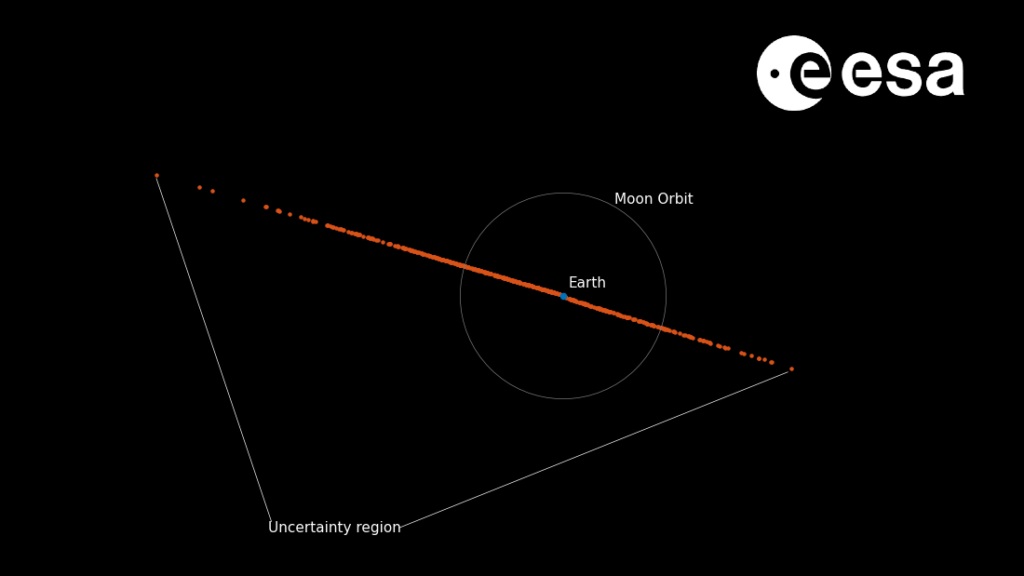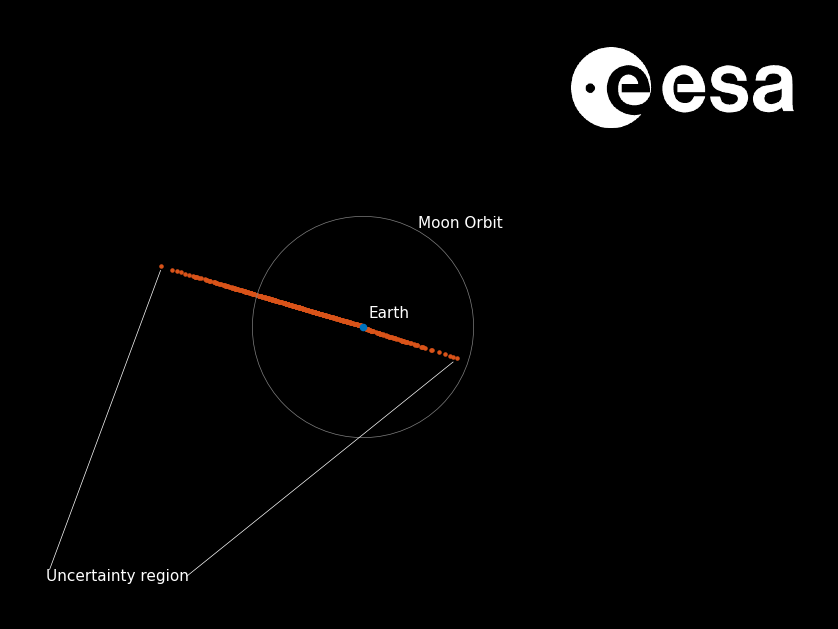On 18 February 2025, the probability that asteroid 2024 YR4 might impact Earth on 22 December 2032, as assessed by ESA’s Near-Earth Object Coordination Centre, rose to 2.8%.
This means that 2024 YR4 has now surpassed the 2.7% chance of impact briefly associated with the much larger asteroid (99942) Apophis back in 2004.
For asteroids larger than 30 metres in size, 2024 YR4 now holds the record for the highest impact probability reached, and the longest time spent with an impact probability greater than 1%.
It is important to note that this rising impact probability is an expected result as we continue to improve our knowledge of the asteroid’s orbit.
As we narrow down where exactly 2024 YR4 will be located on 22 December 2032, Earth fills up a larger fraction of our shrinking uncertainty region.


As more observations of the asteroid are made, the uncertainty region will continue to shrink and the impact probability may continue to rise. If we reach a point at which Earth is no longer inside this region, the impact probability will quickly drop to 0.

Discussion: 8 comments
Is the potential area of the impact still the same or has it changed too?
The risk corridor mapped to Earth’s rotation is still the same.
It would be interesting to learn the probability of impact with Earth’s moon and the predicted consequences of that. We need the Moon.
The Moon will Not destroyed by that tiny thing….
Hi, if the risk of impact would increase over time, do our capabilities today allow for potential redirection, by for instance adjusting designs of DART and RAMSES? What are the main technological roadblocks?
To Doug Snell:
2024 YR4 is 40 to 100 meters in length. The diameter of the craters on the Moon is 10 to 100 times bigger than the body of the impact. So that will give a crater between 0,4 to 10 km in diameter. To see the crater from the Earth it will require a great telescope if it is in the small end and also telescope to see if it is the largest end.
To Debdut Sengupta:
2024 YR4 will In almost four years in December 2028 be near Earth again – this is why it was discovered in December 2024 where its orbit also was relatively close to Earth.
I don’t know how far we can see it before it becomes invisible for us on its way away from us. But the orbit will be determited more presisely so it would be possible to give it a push to get it in an orbit with a predicted path far away from Earth.
But – there could be the small possibillity that on its orbit in its way to aphel and back it would be in close proximity with another asteroid where the orbit will be changed a bit again caused by gravity so it is on the path of hitting Earth again.
Another scenario could be just wait a prepare for an impact situation with risks of tzunamis and direct hit on land where people should be prepared to evacuate. Because we will properly have weeks where we know very precisely where the asteroid would hit if it will impact.
It will be interesting to see what will happen in the comming years before December 2028 and again 2032.
About me: I am not a professional within astronomy in any kind but a reasonable amateur. Claus Agerskov, Agertorium, Albertslund, Denmark
Should we attempt to redirect if it is found that the asteroid is likely to hit the moon?
I guess not. If it hits the moon it’s no longer a threat for earth.
And I don’t think it’s big enough to cause much damage to the moon. Yes, the moon would get a new crater but it has plenty of those already. So there’s no need to protect the moon from it.